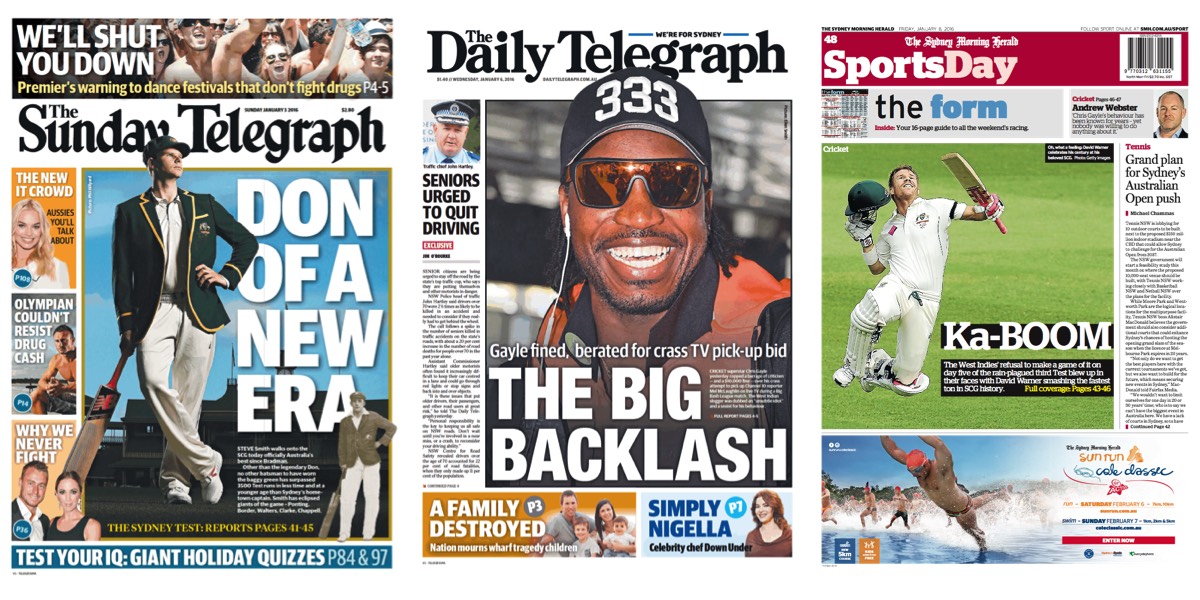By Kruti Joshi
The coverage of cricket in newspapers has changed radically in the past 20 years. This is not only due to the prominence of digital or international news titles entering the Australian market, the change has also been driven by some notable changes in the sport itself.
The deputy sports editor for News Corp’s The Daily Telegraph Peter Fitzgerald told Mediaweek: “The amount of coverage [that cricket] gets hasn’t changed at all. In summer in Australia, if you look at the sports, the summer of cricket was #1 back in the day, and still is #1 now.”
At Fairfax’s The Sydney Morning Herald, the number of stories about cricket has actually increased in the last 20 years, noted the chief sports editor of the masthead Ian Fuge.
“In the past we might have been satisfied with one or two cricket stories from a day’s play at a Test match. Now we are looking to fill eight pages.”
The main cause of the change at The Sydney Morning Herald is digital.
“Very few people nowadays turn to a newspaper to find out what [has] happened in a day’s play, so that traditional blow-by-blow match report has definitely been consigned to history,” Fuge says.
“We assume nowadays that any interested reader is already across the basics of what [has] happened on a given day – they have seen it live, read about it on a blog live, possibly commented on it via Twitter and so on.
“What they [the readers] are looking for from the newspaper is a) something they don’t know in terms of breaking news, b) analysis, or c) terrific writing that may recap what they have already seen but does it in such a way as to offer a unique insight.”
Fitzgerald echoed Fuge’s view, pointing out that it’s not the amount of the coverage that has changed at The Daily Telegraph, it’s “the content [that] has changed dramatically”.
“The tests still get covered and the One Days still get covered, but the Big Bash is in the market now – they’ve got their foothold. The amount of coverage about the Big Bash has increased because of its popularity.
“In five, or 10, or 15 years down the track, who is to say we are not playing five-five cricket where it is five overs per innings, or 10 overs per innings?”
News brands like The Sydney Morning Herald and The Daily Telegraph have a notable presence online. The Sydney Morning Herald site was consistently ranked amongst the top three most-accessed news sites in Australia last year in the monthly Nielsen Online Rankings data. Both mastheads also have an admirable following on social media platforms.
“The electronic media focuses on the as-it-happens coverage, whereas I think it is probably fair to say that if a reader has bought the paper for cricket, they have made a commitment to spending time reading a long, analytical piece and immersing themselves in detailed, long-form coverage of the game,” said Fuge.
“That is not to say that digitally we can’t offer the same thing. We are finding a significant section of our online audience is digitally accessing the traditional long-form journalism that used to be associated mainly with print.”
Talking about how the print and online coverage of cricket complement each other at The Daily Telegraph, Fitzgerald said: “It works through cross promotion. It starts with the story. If we get a breaking story [that] we don’t think will hold for the next day’s newspaper [we publish it online]. Basically, every story we get goes straight up online. That’s just the world we live in.”
But, the cricket coverage in print is equally vital for the paper at News Corp, Fitzgerald added.
“A radio report goes for 30 seconds, and sometimes 15 seconds for a update, and TV news stories go for [about] 90 seconds. Whereas [with] newspapers, you can sit down, [and] you can get the balls of a story.You can get the dramas and the emotion.
“The newspaper has the advantage of giving you the story behind the story.”
On the importance of cricket coverage in print at Fairfax, Fuge said: “It is still significant but less so with the majority of our readers now getting their news online.
“While much of the material that would have traditionally been published for the first time in the morning newspaper is now being published online the evening before. We are still finding that the morning radio and TV news bulletins are taking some of their cues from the morning newspapers. The television and radio focus almost exclusively on what is actually happening as it happens.”
